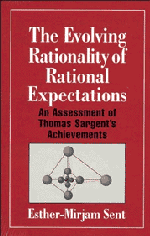4 - Accommodating Symmetry
Published online by Cambridge University Press: 18 December 2009
Summary
Tyger Tyger, burning bright,
In the forests of the night;
What immortal hand or eye,
Could frame thy fearful symmetry?
William Blake, The TygerSymmetry is a deep epistemological problem for the social sciences. If social scientists are asymmetric with their objects of study, then how can they provide an intimate view? And on what is their privileged position based? If social scientists are symmetric with their objects of study, then how can they provide a cool assessment? And why would we take their word over that of the objects of study? This chapter discusses how in the early to mid-1980s Sargent was confronted by the paradoxical nature of symmetry as a result of his eventual interpretation of rational expectations as individual rationality and mutual consistency of perceptions. Section 4.1 gives a few examples of discussions of symmetry in some social sciences. Sargent's attempts at dealing with the symmetry that followed from his combined free moves of vector autoregressions, general equilibrium theory, and rational expectations are considered in section 4.2. Later sections shed some light on Sargent's moves: In particular, section 4.3 sets Sargent's saga in a bigger perspective by appealing to ideas from physics and philosophy. In section 4.4, the view is widened further in a discussion of findings from science studies, which are also used to provide an insight into my perspective.
- Type
- Chapter
- Information
- The Evolving Rationality of Rational ExpectationsAn Assessment of Thomas Sargent's Achievements, pp. 99 - 123Publisher: Cambridge University PressPrint publication year: 1998

